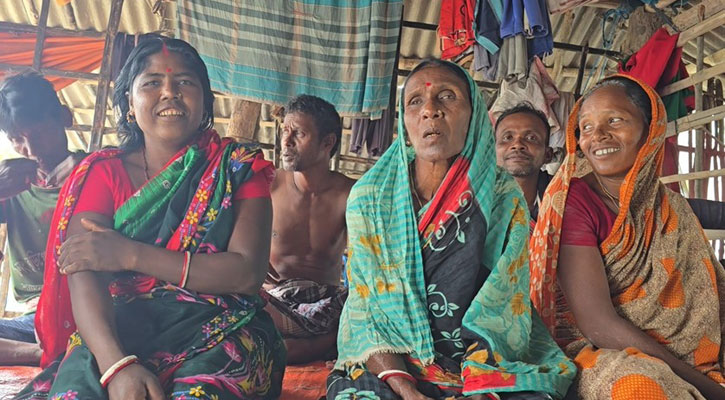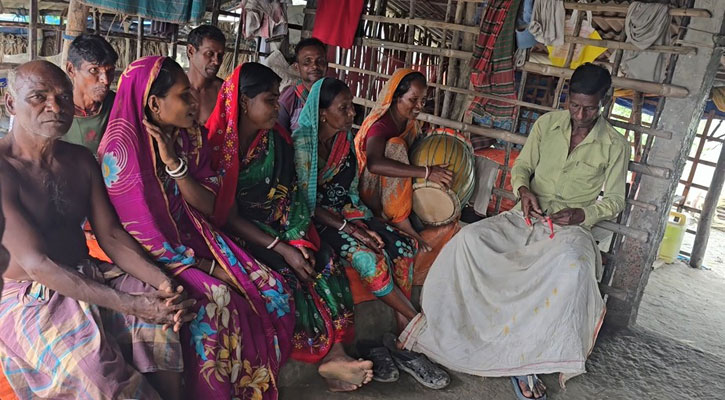The house of Bhakta Munda stands adjacent to a river bordering the Sundarbans. His great-grandfather also lived on this very land.
Within the river grow various trees, among them the Keora tree (Sonneratia apetala). Bhakta Munda is seen picking its fruits, which are used in his household’s lunch preparations—typically cooked into a tangy dish. Being a salt-tolerant mangrove tree, Keora continues to bear fruit even in saline water.
The Munda community is an indigenous group residing in the coastal areas of the Sundarbans. Various studies indicate that they have been living in this region for over 220 to 300 years.
Between 1750 and 1800, the Munda people were relocated from Jharkhand, Bihar, and Chota Nagpur by landlords and British colonial authorities to establish colonies in the coastal areas of the Sundarbans. They cleared forestland to develop agriculture and settlements, making the region their permanent home.
Gautam Munda, now nearly 80 years old according to his family, walks with the support of a cane and sits by the river. He reflects on the transformation of the Datinakhali area in Shyamnagar.
“In the scorching afternoons, we used to cast nets into the river and gather handfuls of snails wrapped in our towels. We’d cook them into a spicy curry, a signature dish of our community. It's been years since I last tasted snails. They’re gone from the river,” he says with a sigh.
In the Munda community’s coastal food culture, freshwater snails were once a vital ingredient. For generations, they consumed species such as Pila globosa (apple snail), Bellamya bengalensis, and Pila polita.
These snails typically inhabit freshwater environments like wetlands, canals, and ponds. The Mundas would collect them and prepare them boiled or in curry. High in protein and minerals, they were considered a nutritious food source.
However, due to climate change and the intrusion of saline water, these freshwater snails are becoming increasingly rare, posing a threat to the community’s traditional diet and livelihood.
Not just snails, but most traditional foods are vanishing from the Munda dietary landscape under the strain of climate change. One such item is shaluk—the tuber of the water lily.
“We used to enjoy eating the lower part of the water lily; it was also quite nutritious. Eating these foods gave us strength for an entire day’s work. Now, our children don’t even recognize them. We used to mash shaluk with coconut and spices—that taste still lingers on my tongue. Saline water has taken that away,” says 64-year-old Dipali Munda.
For the Munda people of Shyamnagar, food was not merely a means of survival—it was a marker of identity, a signal of seasons, and a celebration of life. Children learned about nature by collecting young snails. Now, those foods exist only in memory—not on their plates.
At one time, rats were also considered a known protein source in the Munda food tradition. After harvesting paddy, they would hunt and cook field rats, a deeply rooted cultural practice. But with increasing salinity reducing paddy cultivation, field rats are now scarce. As a result, this unique food habit is fading. An elderly Munda man laments, “Catching rats after the harvest used to feel like a festival. Those days are gone, and so is our communal festivity.”
The indigenous Munda community in Satkhira is now caught in a new reality of food insecurity. A combination of climate change, rising salinity, and the disappearance of forest-sourced foods is eroding a centuries-old food culture.
Salt in the water, sighs on the plate
“Once, we cultivated our own rice and ate starch with it. Now, those fields only yield crabs or bagda (tiger prawns),” says Ajit Munda.
In recent years, cyclones such as Aila, Amphan, and Sitrang have rendered Munda farmland barren. The salinity has increased to the extent that not even a single season of Aman or Boro rice can be harvested. Today, shrimp farmers occupy the fields, while the Munda people stand behind the embankments, displaced.
Once, the Mundas foraged for food from forest sources. Wild carrots-vines, bon-chalta, mushrooms, taro greens, and water lilies along with tubers were a source of culinary pride. But deforestation and the adverse effects of climate change are increasingly depriving them of these foods.
Now store-bought rice served in festivals
In events like Sarhul, Karam, and the new harvest festivals, food was once a cultural cornerstone for the Mundas. They made pithas (rice cakes) from freshly harvested rice, sweets from forest fruits, dried snail curries for special occasions, and 'haria', a homemade rice wine. But all of these are disappearing.
Young Munda woman Basanti says, “My mother used to cook a special shaluk dish for the Karam festival. Now we can’t even find shaluk. We cook pilaf with store-bought rice, but it doesn’t feel festive.”
The traditional Munda liquor haria is typically consumed during social gatherings, weddings, and harvest festivals. It is made by fermenting rice, shredded leaves of the kuja tree (Careya arborea), and water over a week. This natural wine symbolizes their cultural identity and community spirit. But now, with the kuja tree becoming scarce, especially after Cyclone Aila, the production of haria has also declined.
“Our festivals used to include dance, music, and drinks—we called it haria, our homemade wine. But now it doesn’t taste the same because one key ingredient, kuja leaves, is no longer available here after Aila. While climate adaptation efforts have promoted vegetable farming, no one is focusing on the cultural foods we are losing. Those foods were sources of protein and calcium for us. Snails were the easiest source of protein. But saline water is taking all these away, along with our heritage. Food is not just about taste—it’s our identity,” says Krishna Munda, Executive Director of the Sundarbans Indigenous Munda Organization.
Women once ruled the kitchen now struggle
Munda women were traditionally the 'food keepers' in their families and communities. They identified edible greens, cooked snails over open fires, and collected seasonal tubers during monsoon, autumn, or early winter. Today, these same women wade through saline water in search of shrimp fry and crabs to put something on the plate.
Urinary tract infections, skin conditions, and bone diseases now commonly afflict coastal women. Yet, there is no sustainable initiative addressing their health or nutritional needs.
Heritage and identity may be lost if not preserved
A segment published by the Global Forum on Food Security and Nutrition—an initiative under the United Nations' Food and Agriculture Organization (FAO) and its partner coalitions—notes that food insecurity and malnutrition among indigenous populations in Bangladesh, particularly those in the hill tracts and coastal regions, are higher than the national average. The report emphasizes the importance of promoting local and climate-resilient foods such as millets, shaluk (water lily tubers), and wild greens. Without such efforts, the cultural identity, heritage, and food security foundations of indigenous communities may face disintegration.
While some development organizations are working to introduce "climate-smart" agriculture, activists argue that indigenous lives must not be treated merely as development "projects." Instead, sustainable planning should be rooted in their lived experiences, traditional knowledge, and culinary practices. Sharif Jamil, Member-Secretary of the organization Dhora (Dhoritri Rokhhay Amra) stressed the urgent need for active measures to preserve the traditional foods of these communities.











